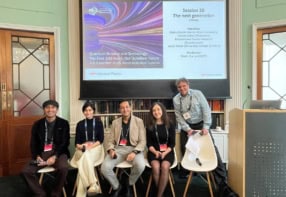
The “information paradox” surrounding black holes has sucked in many noteworthy physicists over the years. For more than three decades Stephen Hawking of Cambridge University in the UK insisted that any information associated with particles swallowed by black holes is forever lost, despite this going against the rule of quantum mechanics that information cannot be destroyed.
When four years ago Hawking famously made a volte-face — that information can be recovered after all — not everyone was convinced. “The general view is that [Hawking’s] argument is not sufficiently detailed,” says Abhay Ashtekar at Penn State University in the US.
Now, Ashekar and colleagues at Penn State claim to have more reliable mechanism that can preserve information dragged into the shadows of black holes.
Not so black after all
The information paradox first surfaced in the early 1970s when Hawking, building on earlier work by Jacob Bekenstein at the Hebrew University of Jerusalem, suggested that black holes are not totally black. He showed that particle–antiparticle pairs generated at a black hole’s periphery, known as its event horizon, would be separated. One would fall into the black hole while the other would escape, making the black hole appear as a radiating body.
Although Hawking famously conceded his bet, he left his original argument for information loss orphaned but alive Steven Giddings, University of California in Santa Barbara
Quantum entanglement demands that the trapped particle would have negative energy and, because of Einstein’s mass-energy equivalence E = mc2, negative mass. With each successive negative-energy particle the black hole would therefore steadily lose mass or “evaporate”. Hawking argued that even after a black hole has totally evaporated it would leave behind its central, infinitely dense point known as the singularity, in which information would be lost forever.
The significance of the information paradox came to a head in 1997 when Hawking, together with colleague Kip Thorne at Caltech, US, put this argument forward as a bet with John Preskill, also at Caltech. Preskill believed that, in accordance with quantum mechanics, information loss is impossible because it prevents the equations governing the process from being reversible. But in 2004 Hawking conceded the bet, saying he now believed that information is returned, although in a disguised state.
Sticking points
Hawking’s revised stance failed to sway other theorists. Aside from the fact that his new theory was based on mathematics that is not obviously relevant to physical space–time, it did not directly address his original argument about the singularity.
The Penn State group, which includes Ashtekar as well as Victor Taveras and Madhavan Varadarajan, claims to have overturned this argument by performing calculations of a black hole model in two dimensions: one space and one time. “In my opinion this remains a very important question to settle,” says Steven Giddings at the University of California in Santa Barbara. “Although Hawking famously conceded his bet, at the time he left his original argument for information loss orphaned but alive. This new work appears to have found improved control over the calculations.”
The advantage of working in two dimensions is that it has allowed Ashtekar’s group to write down exact quantum equations governing the gravity at a black hole, which they can evaluate using two approximations. The first is a “bootstrapping” process, essentially reaching a solution for the equations using a series of better-informed guesses. “Bootstrapping serves to demonstrate that quantum geometry can be perfectly regular even when the classical geometry acquires singularities,” explains Ashtekar.
Second is a “mean field” approximation that finds a solution for the region away from the centre of the black hole. It was using this approximation that Ashtekar’s group discovered the inner region approaching infinite density is much larger than previously thought using classical arguments — large enough to allow the recovery of information (Phys. Rev. Lett. in publication; preprint at arXiv:0801.1811).
It strongly suggests that black hole evaporation does not destroy information Seth Lloyd, Massachusetts Institute of Technology
‘Not convinced’
Preskill, who accepted Hawking’s 2004 concession even though he was doubtful of his theory, is also “not convinced” of the Penn State research — though he notes that he has not yet studied it carefully. “I thought we made a pretty strong case back in 1994 that models of this type exhibit information loss…I don’t see how the observations by Ashtekar et al. change that conclusion, but I may be missing something.” Thorne, who was also dubious of Hawking’s concession at the time, did not want to comment because he is not familiar with this particular field of research.
Other theorists think Ashtekar’s group have made an important development, though they add that the debate is still not over. “After some extended discussions with Abhay, I am not yet convinced that they have shown the information comes out,” says Giddings.
“It is indeed very interesting,” says Seth Lloyd of the Massachusetts Institute of Technology. “It strongly suggests, although it does not prove, that black hole evaporation in one-plus-one dimensions does not destroy information: all information escapes as the black hole evaporates…[but] it is not clear that the derivation would work in three-plus-one dimensions.”



